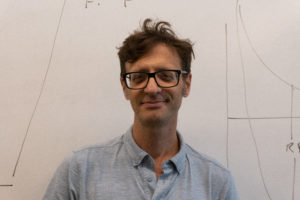John Galbraith, Marist College – Chemical Bonding
 Our understanding of chemical bonding might need an update.
Our understanding of chemical bonding might need an update.
John Galbraith, associate professor of chemistry at Marist College, explains why.
In 1992 I received my BA in Chemistry from the Colorado College in Colorado Springs, CO and my PhD in Physical Chemistry in 1997 from the University of Georgia in Athens, GA. While at the University of Georgia, I worked with Professor Henry F. Schaefer III on computational studies of small molecules. From 1997 to 1999 I held a postdoctoral position at the Hebrew University in Jerusalem, Israel working with Sason Shaik. In Israel I began the line of research that occupies me to this day: computational studies of chemical bonding using Valence Bond theory. I held a second postdoctoral position at the University of Washington in Seattle, WA where my duties were split between teaching General Chemistry and doing Computational Chemistry research with Weston Thatcher Borden. Beginning in the Fall of 2001 I have been on the faculty at Marist College as an Assistant (2001-2007) and Associate (2007- ) professor of Chemistry. While at Marist I have taught courses in General Chemistry, Introduction to Organic Chemistry, Physical Chemistry, Advanced Inorganic Chemistry, Computational Chemistry, and Research Methods all the while conducting research primarily with undergraduates. I have published 31 peer reviewed articles, 10 of which were with undergraduate authors, in Journals such as The Journal of The Journal of Physical Chemistry, Molecular Physics, and Analytical and Bioanalytical Chemistry. In addition, I have served as a referee for The Journal of Physical Chemistry, The Journal of Chemical Theory and Computation, Molecular Physics, and the American Chemical Society Petroleum Research Fund as well as serving on the editorial board of ISRN Physical Chemistry.
Chemical Bonding
The elements of the periodic table are the building blocks that make up all matter in the universe. Currently, there are only 118 elements that we know of, yet there are an infinite number of ways these elements can combine to create the diverse array of materials all around us.
My work is focused on chemical bonding, the process by which individual atoms of the elements come together to make molecules. I use valence bond theory which is rooted in the mathematics of quantum mechanics and allows for the determination of the source of a bond by breaking it down into individual energy contributions. This is only possible with the help of modern computers that can quickly and reliably perform repetitive calculations.
This approach has led to the discovery of a new form of chemical bonding, charge-shift bonding. For over 100 years the prevailing view has been that chemical bonds are either covalent, where electrons are shared, or ionic, where electrons are completely transferred. However, valence bond theory calculations have shown that certain bonds are unstable when considered as covalent or ionic alone. In these cases, the bond only exists as a resonance hybrid, or mixture, of covalent and ionic contributions.
Charge-shift bonding is not a rare occurrence that only appears in exotic molecules. For example, the F2 molecule, long used as a textbook example of covalent bonding, actually has a charge-shift bond.
Originally just a theoretical construct, there is a growing body of experimental evidence that verifies the charge-shift bonding concept. We are currently working on identifying charge-shift bonding cases across the periodic table and validating the concept so that it will be considered alongside covalent and ionic as a distinct form of chemical bonding. Ultimately, if we can understand chemical bonding, we can control the process and make new materials with useful properties.
Read More:
Wiley Online Library – Charge‐Shift Bonding: A New and Unique Form of Bonding



Still growing & thanks. Or compounding.
Chemistry = Biology., Or as a teacher on tumblr said his H.S.teacher told him” Chemistry is the science of Death.”
S.H.Smith,A.A.,B.S.*